Opportunities for the Transformation and Development of Power Plants Under Water Stress Conditions: Example of Adamów Power Plant
Abstract
1. Introduction
2. Methodology and Research Material
2.1. Area of Research
2.1.1. Catchment Area of Kiełbaska Duża and Teleszyna Rivers
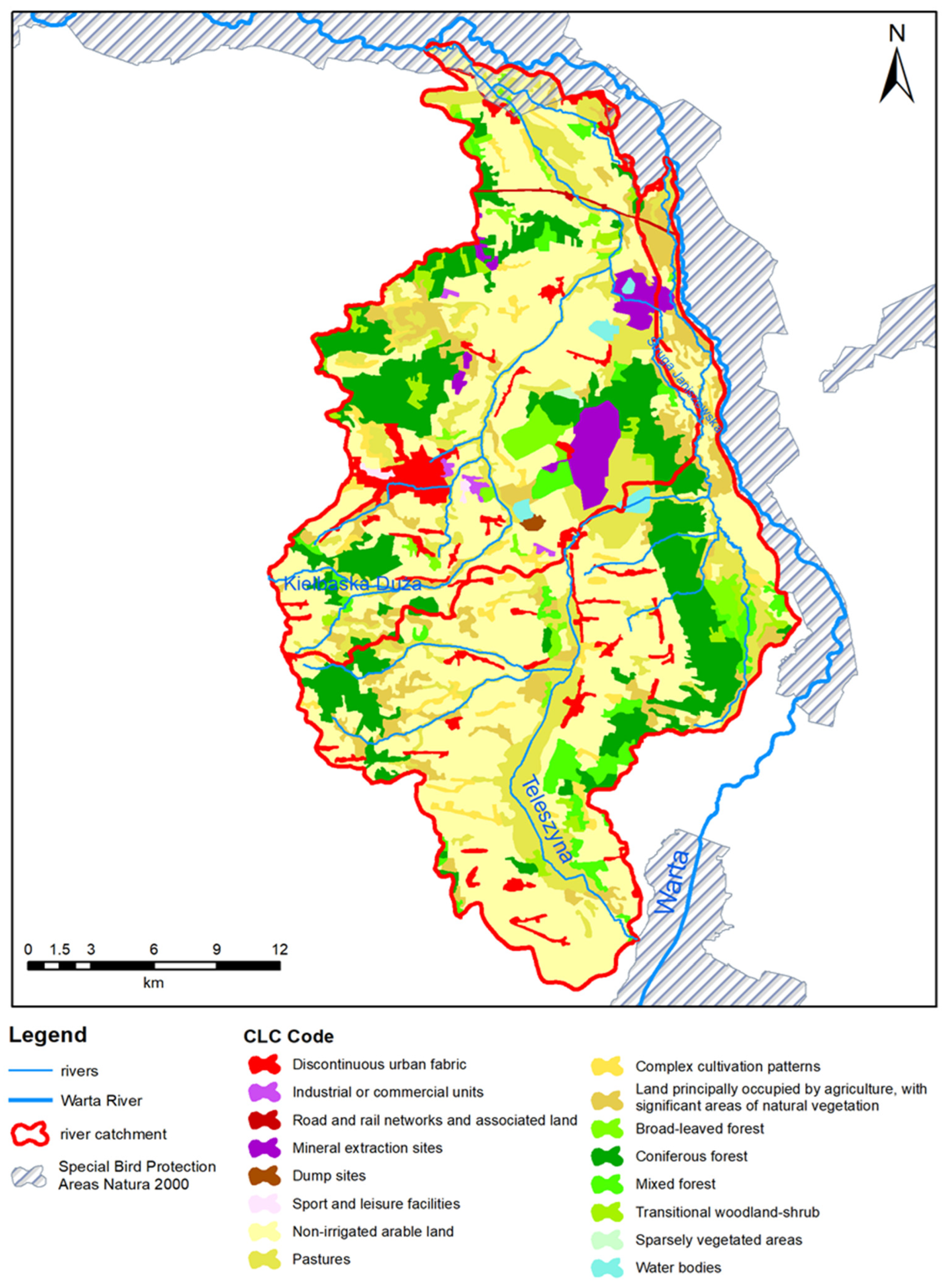
2.1.2. Adamów Power Plant and the Planned Gas and Steam Unit
2.2. Methodology
2.3. Hydrological Scenarios
2.3.1. Scenario 0—Current Situation
2.3.2. Scenario 1—Planned Changes
2.3.3. Scenario 2—Long-Term Projections
3. Results
3.1. Water Stress Analysis in the Catchment Area of the Kiełbaska Duża
3.2. Analysis of Hydrological Scenario Results
3.3. Comparison of a Conventional Lignite-Fired Power Plant and a Steam and Gas Turbine Power Plant
- The selected variant complies with the objectives of Poland’s Energy Policy until 2040. One of the main objectives of the Policy is to improve the security of fuel and energy supplies. The energy policy focuses on the rational and efficient management of the fuel reserves available in the country;
- The expected impact of the selected variant on specific components of the environment, especially on air quality, will be smaller than the impact of a conventional lignite-fired unit of the same capacity.
4. Discussion
5. Conclusions
- Water stress in the Kiełbaska Duża river basin occurs for about 54% of the hydrological year;
- To reduce the water deficit, it is necessary to use inter-basin water transfers using pumping stations with a flow rate of 0.347 m3/s;
- The annual water demand will be 5.95 million m3 with water being transferred from the Jeziorska reservoir on the Warta river;
- Restoring the natural courses of the Kiełbaska Duża and Teleszyna rivers will contribute to the improvement in the hydrological situation;
- There is potential to build retention reservoirs in former mining excavations with a total capacity of 900 million m3 and an area of 3500 ha was identified;
- The modernisation of power units and their conversion to gas–steam units will reduce water consumption and increase energy efficiency;
- Ending the exploitation of lignite and gradually restoring natural water circulation in the catchment area will have a positive impact on the stabilisation of the hydrological cycle;
- The actions being taken are a model example of the synergy of energy and hydrotechnical transformation.
Author Contributions
Funding
Data Availability Statement
Conflicts of Interest
References
- Intergouvernemental Panel on Climate Change (Ed.) Climate Change 2013: The Physical Science Basis; Cambridge University Press: New York, NY, USA, 2014; ISBN 978-1-107-05799-9. [Google Scholar]
- Kubiak-Wójcicka, K.; Machula, S. Influence of Climate Changes on the State of Water Resources in Poland and Their Usage. Geosciences 2020, 10, 312. [Google Scholar] [CrossRef]
- Xu, H.; Wu, M. A First Estimation of County-Based Green Water Availability and Its Implications for Agriculture and Bioenergy Production in the United States. Water 2018, 10, 148. [Google Scholar] [CrossRef]
- Kałuża, T.; Hämmerling, M.; Zawadzki, P.; Czekała, W.; Kasperek, R.; Sojka, M.; Mokwa, M.; Ptak, M.; Szkudlarek, A.; Czechlowski, M.; et al. The Hydropower Sector in Poland: Barriers and the Outlook for the Future. Renew. Sustain. Energy Rev. 2022, 163, 112500. [Google Scholar] [CrossRef]
- Van Vliet, M.T.H.; Wiberg, D.; Leduc, S.; Riahi, K. Power-Generation System Vulnerability and Adaptation to Changes in Climate and Water Resources. Nat. Clim. Chang. 2016, 6, 375–380. [Google Scholar] [CrossRef]
- Ptak, M.; Sojka, M.; Kałuża, T.; Choiński, A.; Nowak, B. Long-Term Water Temperature Trends of the Warta River in the Years 1960–2009. Ecohydrol. Hydrobiol. 2019, 19, 441–451. [Google Scholar] [CrossRef]
- Hammerling, M.; Walczak, N.; Kałuża, T.; Oliskiewicz-Krzywicka, A. Operational Problems of Selected Elements of the Dobrzyca Barrage on the Głomia River. Annu. Set Environ. Prot. 2018, 20, 163–183. [Google Scholar]
- Gruszczyński, M.; Kałuża, T.; Mazurkiewicz, J.; Zawadzki, P.; Pawlak, M.; Matz, R.; Dach, J.; Czekała, W. Preparation of Samples for the Study of Rheological Parameters of Digested Pulps in a Bioreactor of an Agricultural Biogas Plant. Energies 2024, 17, 965. [Google Scholar] [CrossRef]
- Mekonnen, M.M.; Hoekstra, A.Y. Four Billion People Facing Severe Water Scarcity. Sci. Adv. 2016, 2, e1500323. [Google Scholar] [CrossRef]
- Wada, Y.; Flörke, M.; Hanasaki, N.; Eisner, S.; Fischer, G.; Tramberend, S.; Satoh, Y.; Van Vliet, M.T.H.; Yillia, P.; Ringler, C.; et al. Modeling Global Water Use for the 21st Century: The Water Futures and Solutions (WFaS) Initiative and Its Approaches. Geosci. Model Dev. 2016, 9, 175–222. [Google Scholar] [CrossRef]
- Fricko, O.; Parkinson, S.C.; Johnson, N.; Strubegger, M.; Vliet, M.T.V.; Riahi, K. Energy Sector Water Use Implications of a 2 °C Climate Policy. Environ. Res. Lett. 2016, 11, 034011. [Google Scholar] [CrossRef]
- Pfister, S.; Saner, D.; Koehler, A. The Environmental Relevance of Freshwater Consumption in Global Power Production. Int. J. Life Cycle Assess. 2011, 16, 580–591. [Google Scholar] [CrossRef]
- Holland, R.A.; Scott, K.A.; Flörke, M.; Brown, G.; Ewers, R.M.; Farmer, E.; Kapos, V.; Muggeridge, A.; Scharlemann, J.P.W.; Taylor, G.; et al. Global Impacts of Energy Demand on the Freshwater Resources of Nations. Proc. Natl. Acad. Sci. USA 2015, 112, E6707–E6716. [Google Scholar] [CrossRef] [PubMed]
- Hämmerling, M.; Walczak, N.; Kałuża, T. Analysis of the Influence of Hydraulic and Hydrological Factors on the Operating Conditions of a Small Hydropower Station on the Example of the Stary Młyn Barrage on the Głomia River in Poland. Energies 2023, 16, 6905. [Google Scholar] [CrossRef]
- Koch, H.; Vögele, S. Dynamic Modelling of Water Demand, Water Availability and Adaptation Strategies for Power Plants to Global Change. Ecol. Econ. 2009, 68, 2031–2039. [Google Scholar] [CrossRef]
- Piemontese, L.; Fetzer, I.; Rockström, J.; Jaramillo, F. Future Hydroclimatic Impacts on Africa: Beyond the Paris Agreement. Earths Future 2019, 7, 748–761. [Google Scholar] [CrossRef]
- Zaninelli, P.G.; Menéndez, C.G.; Falco, M.; López-Franca, N.; Carril, A.F. Future Hydroclimatological Changes in South America Based on an Ensemble of Regional Climate Models. Clim. Dyn. 2019, 52, 819–830. [Google Scholar] [CrossRef]
- Greve, P.; Orlowsky, B.; Mueller, B.; Sheffield, J.; Reichstein, M.; Seneviratne, S.I. Global Assessment of Trends in Wetting and Drying over Land. Nat. Geosci. 2014, 7, 716–721. [Google Scholar] [CrossRef]
- Ponce-Campos, G.E.; Moran, M.S.; Huete, A.; Zhang, Y.; Bresloff, C.; Huxman, T.E.; Eamus, D.; Bosch, D.D.; Buda, A.R.; Gunter, S.A.; et al. Ecosystem Resilience despite Large-Scale Altered Hydroclimatic Conditions. Nature 2013, 494, 349–352. [Google Scholar] [CrossRef]
- Kałuża, T.; Hämmerling, M.; Zawadzki, P.; Czekała, W.; Kasperek, R.; Sojka, M.; Mokwa, M.; Ptak, M.; Szkudlarek, A.; Czechlowski, M.; et al. The Hydropower Sector in Poland: Historical Development and Current Status. Renew. Sustain. Energy Rev. 2022, 158, 112150. [Google Scholar] [CrossRef]
- Spang, E.S.; Moomaw, W.R.; Gallagher, K.S.; Kirshen, P.H.; Marks, D.H. The Water Consumption of Energy Production: An International Comparison. Environ. Res. Lett. 2014, 9, 105002. [Google Scholar] [CrossRef]
- Koseoglu-Imer, D.Y.; Oral, H.V.; Coutinho Calheiros, C.S.; Krzeminski, P.; Güçlü, S.; Pereira, S.A.; Surmacz-Górska, J.; Plaza, E.; Samaras, P.; Binder, P.M.; et al. Current Challenges and Future Perspectives for the Full Circular Economy of Water in European Countries. J. Environ. Manag. 2023, 345, 118627. [Google Scholar] [CrossRef] [PubMed]
- Proust, K.; Dovers, S.; Foran, B.; Newell, B.; Steffen, W.; Troy, P. Climate, Energy and Water: Accounting for the Links; Land and Water Australia: Canberra, Australia, 2007; p. 68.
- Scott, J.; Rajamani, L. EU Climate Change Unilateralism. Eur. J. Int. Law 2012, 23, 469–494. [Google Scholar] [CrossRef]
- Russo, S.; Dosio, A.; Sterl, A.; Barbosa, P.; Vogt, J. Projection of Occurrence of Extreme Dry-wet Years and Seasons in Europe with Stationary and Nonstationary Standardized Precipitation Indices. J. Geophys. Res. Atmos. 2013, 118, 7628–7639. [Google Scholar] [CrossRef]
- Byers, E.A.; Qadrdan, M.; Leathard, A.; Alderson, D.; Hall, J.W.; Amezaga, J.M.; Tran, M.; Kilsby, C.G.; Chaudry, M. Cooling Water for Britain’s Future Electricity Supply. Proc. Inst. Civ. Eng.-Energy 2015, 168, 188–204. [Google Scholar] [CrossRef]
- Macknick, J.; Sattler, S.; Averyt, K.; Clemmer, S.; Rogers, J. The Water Implications of Generating Electricity: Water Use across the United States Based on Different Electricity Pathways through 2050. Environ. Res. Lett. 2012, 7, 045803. [Google Scholar] [CrossRef]
- Sutkowski, M.; Sumara, A. Gaz i Węgiel w Elektrowniach Oraz Elektrociepłowniach. Paliwa Energ. 2013, 1. [Google Scholar]
- Kamiński, A.; Koziczyński, P. Wytwarzanie Energii w Blokach Gazowo–Parowych–Bezpieczeństwo i Przewaga Ekologiczna. Rynek Energii 2015, 1, 50–56. [Google Scholar]
- Pietruszyński, J.; Czopik-Barecka, A.; Rudziński, D.; Wiśniewski, G.; Zawicki, K.; Kwiecień, K.; Nowakowska, P.; Wysocka, P.; Biniek, P.; Drozdowski, W. Zużycie Wody w Produkcji Energii Elektrycznej. Available online: https://www.cire.pl/artykuly/materialy-problemowe/151558-zuzycie-wody-w-produkcji-energii-elektrycznej (accessed on 5 November 2024).
- Available online: www.forum-energii.eu/Rocznik-Dane-o-Energetyce (accessed on 2 November 2024).
- Kasiński, J.R. Badania Geologii Złóż Węgla Brunatnego w Państwowym Instytucie Geologicznym. Przegląd Geol. 2019, 67, 584–586. [Google Scholar]
- Galiniak, G.; Polak, K.; Różkowski, K.; Kaznowska-Opala, K.; Pawlecka, K. Rekultywacja Wodna Jako Czynnik Determinujący Sukces Branży Górnictwa Odkrywkowego w Praktyce Sozologicznej. Przegląd Gór. 2014, 70, 122–127. [Google Scholar]
- Orlikowski, D.; Szwed, L. Wodny Kierunek Rekultywacji w KWB “Adamów” SA-Inwestycją w Przyszłość Regionu. Gór. Geoinżynieria 2009, 33, 351–361. [Google Scholar]
- Gilewska, M.; Otremba, K.; Cejdler, J.; Siera, W. Kształtowanie Środowiska Przyrodniczego Na Terenach Poeksploatacyjnych Odkrywki „Władysławów”. Węgiel Brunatny 2013, 2, 15–18. [Google Scholar]
- Gilewska, M.; Otremba, K. FUNCTIONS OF HYDROLOGICAL OBJECTS IN THE AREAS OF POST-MINING OPEN PIT “WŁADYSŁAWÓW”. Inż. Ekol. 2015, 44, 104–108. [Google Scholar] [CrossRef] [PubMed][Green Version]
- Nowak, B.; Szadek, P.; Rosa, J. Analiza Możliwości Przyspieszenia Odbudowy Zasobów Wodnych w Rejonie Górnej Noteci i Zalewanego Wyrobiska Końcowego Odkrywki Lubstów (Polska Środkowo-Zachodnia). Gospod. Wodna 2022, 1, 4–17. [Google Scholar] [CrossRef]
- Kundzewicz, Z.W.; Piniewski, M.; Mezghani, A.; Okruszko, T.; Pińskwar, I.; Kardel, I.; Hov, Ø.; Szcześniak, M.; Szwed, M.; Benestad, R.E.; et al. Assessment of Climate Change and Associated Impact on Selected Sectors in Poland. Acta Geophys. 2018, 66, 1509–1523. [Google Scholar] [CrossRef]
- Song, X.; Zhuang, Y.; Wang, X.; Li, E.; Zhang, Y.; Lu, X.; Yang, J.; Liu, X. Analysis of Hydrologic Regime Changes Caused by Dams in China. J. Hydrol. Eng. 2020, 25, 05020003. [Google Scholar] [CrossRef]
- Laković, M.; Banjac, M.; Jović, M.; Mitrović, D. Coal-Fired Power Plants Energy Efficiency and Climate Change-Current State and Future. Facta Univ. Ser. Work. Living Environ. Prot. 2016, 12, 217–227. [Google Scholar]
- Wrzesinski, D. Wpływ Procesów Antropogenicznych Na Wielkość Odpływu Rzecznego Ze Szczególnym Uwzględnieniem Zjawisk Ekstremalnych Na Przykładzie Kiełbaski i Widawki. Badania Fizjogr. Nad Pol. Zachodnią Ser. Geogr. Fiz. 1996, 47, 127–141. [Google Scholar]
- Przybyłek, J. Środowiskowe Uwarunkowania Skutków Odkrywkowej Eksploatacji Węgla Brunatnego Na Pojezierzu Gnieźnieńskim. Przegląd Geol. 2020, 68, 645–654. [Google Scholar] [CrossRef]
- Tomaszewski, E. Dynamika Niedoborów Odpływu Niżówkowego w Rzekach Poddanych Silnej Antropopresji. In Monografie Komisji Hydrologicznej PTG Tom 2: Woda w Mieście; Ciupa, T., Suligowski, R., Eds.; Instytut Geografii, Uniwersytet Jana Kochanowskiego w Kielcach: Kielce, Poland, 2014; pp. 289–300. [Google Scholar]
- Fagiewicz, K. Shaping the Water Conditions in the Postmining Areas (a Case-Study of Brown Coal Mine “Adamów”). Civ. Environ. Eng. Rep. 2013, 11, 41–53. [Google Scholar]
- Fagiewicz, K.; Mękarski, M. Ecological and Social Aspects in the Managementof Post-Mining Areas. an Example of the Adamów Lignite Basin. Civ. Environ. Eng. Rep. 2018, 28, 50–64. [Google Scholar]
- Available online: https://land.copernicus.eu (accessed on 2 November 2024).
- Available online: https://meteo.imgw.pl (accessed on 1 November 2024).
- Kasztelewicz, Z.; Kaczorowski, J.; Mazurek, S.; Orlikowski, D.; Żuk, S. Stan Obecny i Strategia Rozwoju Branży Węgla Brunatnego w I Połowie XXI Wieku w Polsce. Gór. Geoinżynieria 2009, 33, 213–231. [Google Scholar]
- Gawlik, L.; Mokrzycki, E. Fossil Fuels in the National Power Sector-Problems and Challenges. Polityka Energy Policy J. 2017, 20, 5–25. [Google Scholar]
- Available online: https://zepak.com.pl/pl/o-Firmie/Elektrownie/Elektrownia-Adamow.html (accessed on 8 December 2024).
- Kotowski, W. Elektrownie Nowej Generacji. Czysta Energ. 2007. [Google Scholar]
- Available online: https://www.apgw.gov.pl/ (accessed on 20 November 2024).
- Kaczorowska, Z. Opady w Polsce w Przekroju Wieloletnim: Tenencje, Okresowość Oraz Prawdopodobieństwo Występowania Niedoboru i Nadmiaru Opadów = Precipitation in Poland in Long-Period Averages = Osadki v Pol’še v Mnogoletnem Razreze; Prace Geograficzne/Polska Akademia Nauk; Instytut Geografii; IGiPZ PAN: Warszawa, Poland, 1962. [Google Scholar]
- Kaleta, Ł.; Śluzar, J. Raport o Oddziaływaniu Na Środowisko Przedsięwzięcia Pod Nazwą: „Budowa Bloku CCGT Klasy 600MWe Wraz z Infrastrukturą Towarzyszącą Na Terenie Elektrowni Adamów”.
- Hański, A.; Terlecki, P.; Popielewska-Jaworska, E.; Krukowski, T.; Konieczny, T.; Kallas-Garnitz, M. Opracowanie Danych Hydrologicznych Na Potrzeby Oceny Zasobów Wodnych Rzek Teleszyna i Kiełbaska; Wydział Prognoz i Opracowań Hydrologicznych w Poznaniu: Poznań, Poland, 2023. [Google Scholar]
- Available online: https://danepubliczne.imgw.pl/ (accessed on 8 December 2024).
- Razeghi, M.; Hajinezhad, A.; Naseri, A.; Noorollahi, Y.; Moosavian, S.F. Multi-Criteria Decision for Selecting a Wind Farm Location to Supply Energy to Reverse Osmosis Devices and Produce Freshwater Using GIS in Iran. Energy Strategy Rev. 2023, 45, 101018. [Google Scholar] [CrossRef]
- Dehnavi, S.; Al-Saidi, M. Educating Water Professionals for the Arab World: Archetypes, Change Agents and Complex Realities. Energy Rep. 2020, 6, 106–113. [Google Scholar] [CrossRef]
- Zhao, X.; Liu, J.; Liu, Q.; Tillotson, M.R.; Guan, D.; Hubacek, K. Physical and Virtual Water Transfers for Regional Water Stress Alleviation in China. Proc. Natl. Acad. Sci. USA 2015, 112, 1031–1035. [Google Scholar] [CrossRef] [PubMed]
- Fleischli, S.; Hayat, B. Power Plant Cooling and Associated Impacts: The Need to Modernize US Power Plants and Protect Our Water Resources and Aquatic Ecosystems. Nat. Resour. Def. Counc. 2014. Available online: https://www.nrdc.org/sites/default/files/power-plant-cooling-IB.pdf?utm_campaign=Bundle&utm_medium=referral&utm_source=Bundle (accessed on 8 December 2024).
- Zhang, X.; Liu, J.; Tang, Y.; Zhao, X.; Yang, H.; Gerbens-Leenes, P.W.; Van Vliet, M.T.H.; Yan, J. China’s Coal-Fired Power Plants Impose Pressure on Water Resources. J. Clean. Prod. 2017, 161, 1171–1179. [Google Scholar] [CrossRef]
- Farat, R. Atlas Klimatu Województwa Wielkopolskiego; IMGW: Poznań, Poland, 2004. [Google Scholar]
- Kedziora, A. Bilans Wodny Krajobrazu Koninskich Kopalni Odkrywkowych w Zmieniajacych Sie Warunkach Klimatycznych. Rocz. Glebozn. 2008, 59, 104–118. [Google Scholar]
- Tina, G.M.; Nicolosi, C.F. Assessment of the Impacts of Climate Change on Power Systems: The Italian Case Study. Appl. Sci. 2021, 11, 11821. [Google Scholar] [CrossRef]
- Tobin, I.; Greuell, W.; Jerez, S.; Ludwig, F.; Vautard, R.; Van Vliet, M.T.H.; Bréon, F.-M. Vulnerabilities and Resilience of European Power Generation to 1.5 °C, 2 °C and 3 °C Warming. Environ. Res. Lett. 2018, 13, 044024. [Google Scholar] [CrossRef]
- Bloomfield, H.C.; Brayshaw, D.J.; Troccoli, A.; Goodess, C.M.; De Felice, M.; Dubus, L.; Bett, P.E.; Saint-Drenan, Y.-M. Quantifying the Sensitivity of European Power Systems to Energy Scenarios and Climate Change Projections. Renew. Energy 2021, 164, 1062–1075. [Google Scholar] [CrossRef]
- De Andrade, J.G.P.; Barbosa, P.S.F.; Souza, L.C.A.; Makino, D.L. Interbasin Water Transfers: The Brazilian Experience and International Case Comparisons. Water Resour. Manag. 2011, 25, 1915–1934. [Google Scholar] [CrossRef]
- Aeschbach-Hertig, W.; Gleeson, T. Regional Strategies for the Accelerating Global Problem of Groundwater Depletion. Nat. Geosci. 2012, 5, 853–861. [Google Scholar] [CrossRef]
- Liu, J.; Zang, C.; Tian, S.; Liu, J.; Yang, H.; Jia, S.; You, L.; Liu, B.; Zhang, M. Water Conservancy Projects in China: Achievements, Challenges and Way Forward. Glob. Environ. Chang. 2013, 23, 633–643. [Google Scholar] [CrossRef]
- Campos, J.D. Cobrança Pelo uso da Água nas Transposições da Bacia do Rio Paraíba do Sul Envolvendo o Setor Elétrico. Master’s Thesis, COPPE/UFRJ, Rio de Janeiro, Brazil, 2001. [Google Scholar]
- Braga, B.P.F.; Strauss, C.; Paiva, F. Water Charges: Paying for the Commons in Brazil. Int. J. Water Resour. Dev. 2005, 21, 119–132. [Google Scholar] [CrossRef]
- Barbara, S. Gierszewski Piotr Charakterystyka I Znaczenie Gospodarcze Kanału Ślesińskiego-Characteristics and Economic Importance of the Ślesiński Canal. 2016. Available online: https://zenodo.org/records/56745 (accessed on 22 September 2024).
- Zaporowski, B. Transformacja Energetyczna Jest Niezbędna i Możliwa. Acad. Mag. Pol. Akad. Nauk 2021, 12, 50–55. [Google Scholar] [CrossRef]
- Energy Transition: ENGIE’s 2020 Dashboard, Thermal Electricity. Available online: https://www.engie.com/en/dashboard-energy-transition-2020 (accessed on 25 September 2024).
- Roemer, K.F.; Haggerty, J.H. Coal Communities and the U.S. Energy Transition: A Policy Corridors Assessment. Energy Policy 2021, 151, 112112. [Google Scholar] [CrossRef]
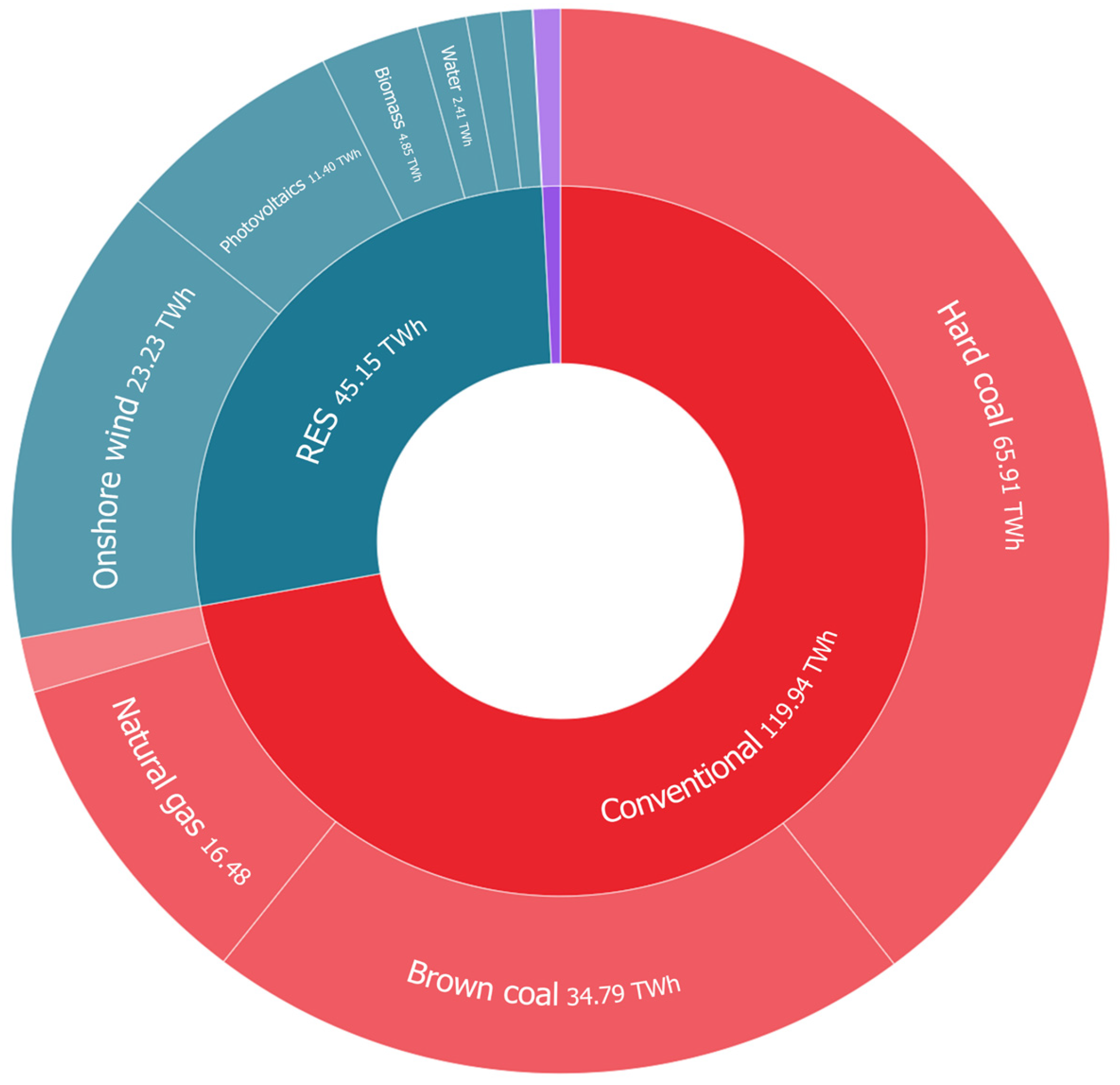

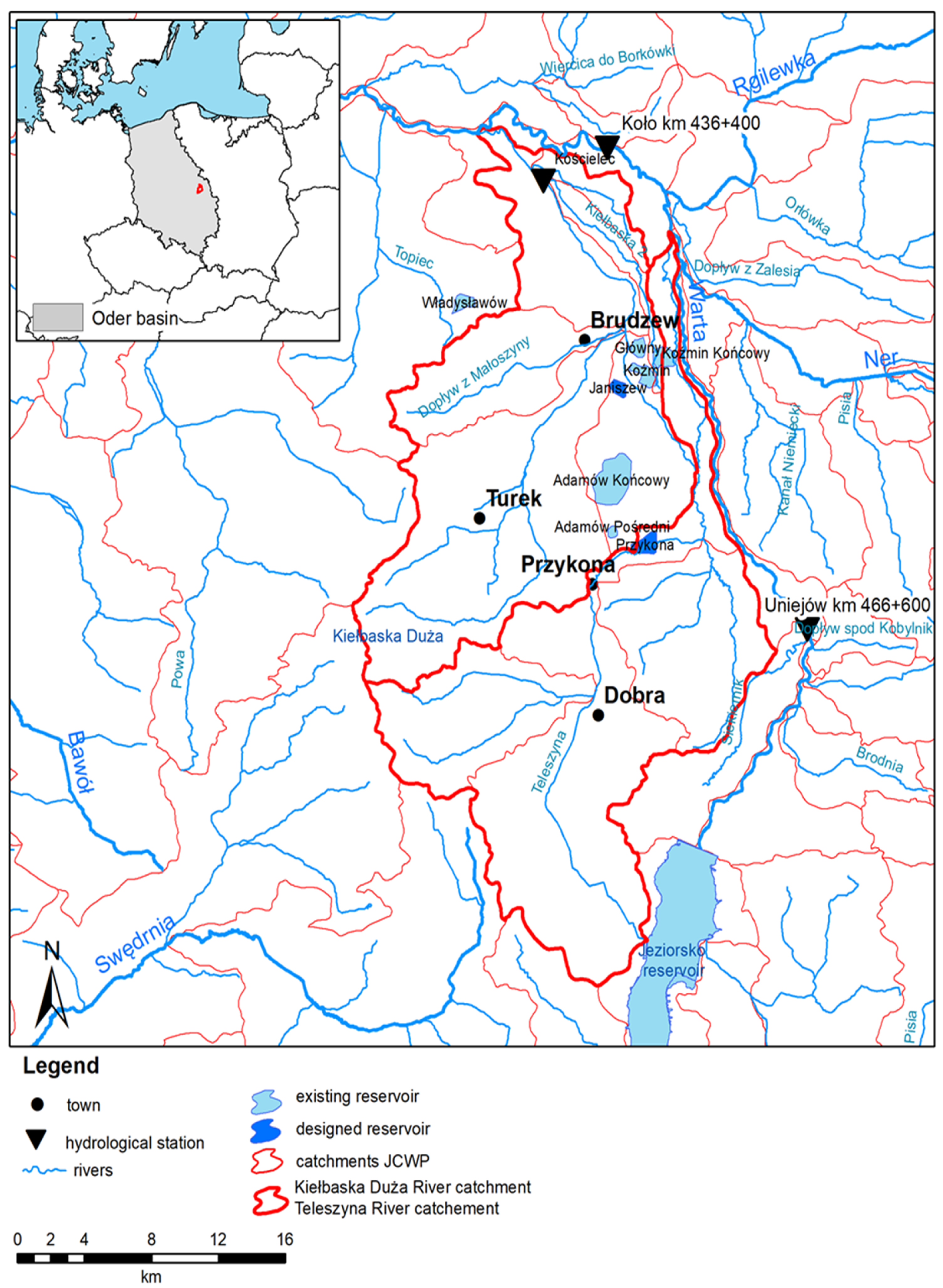

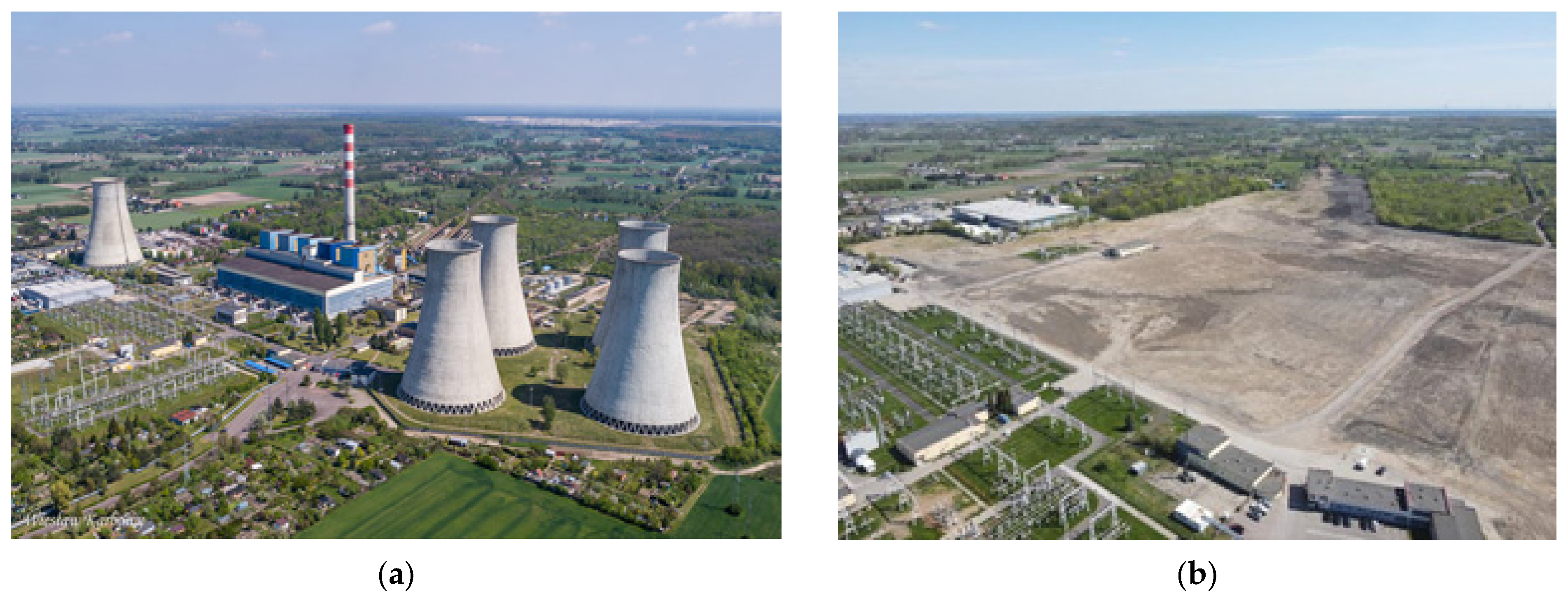

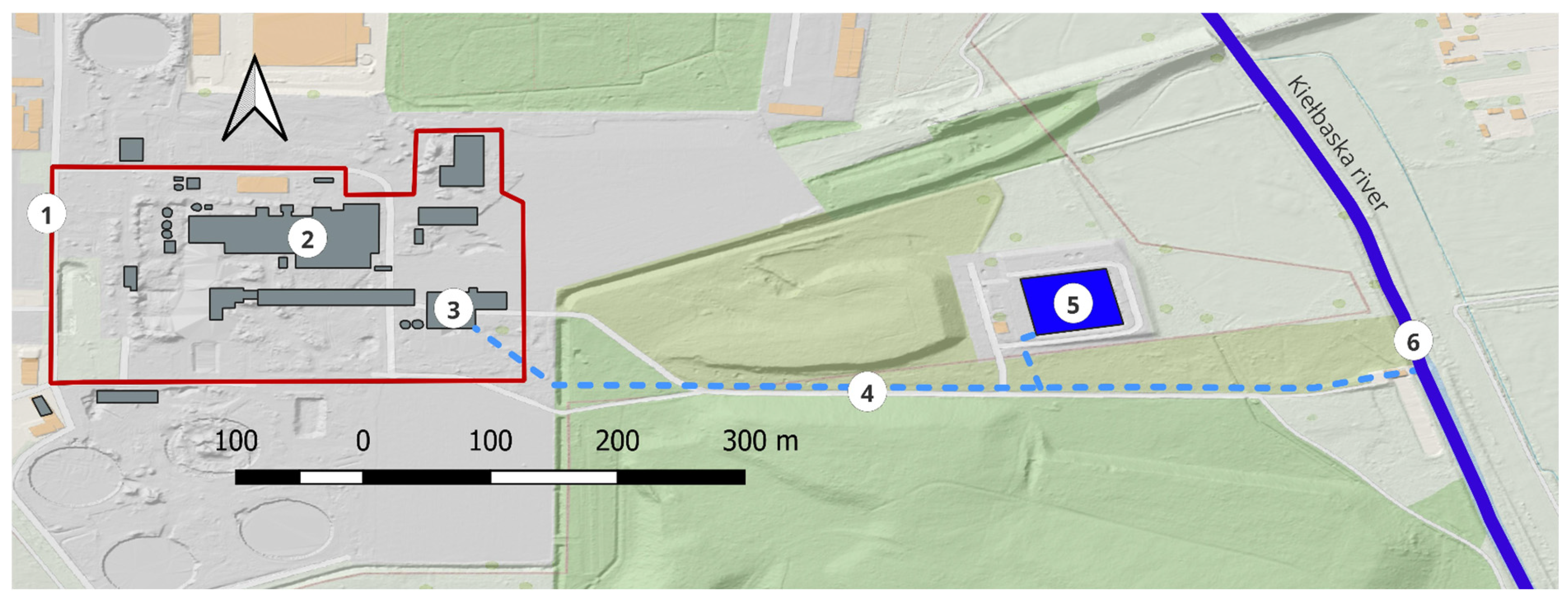
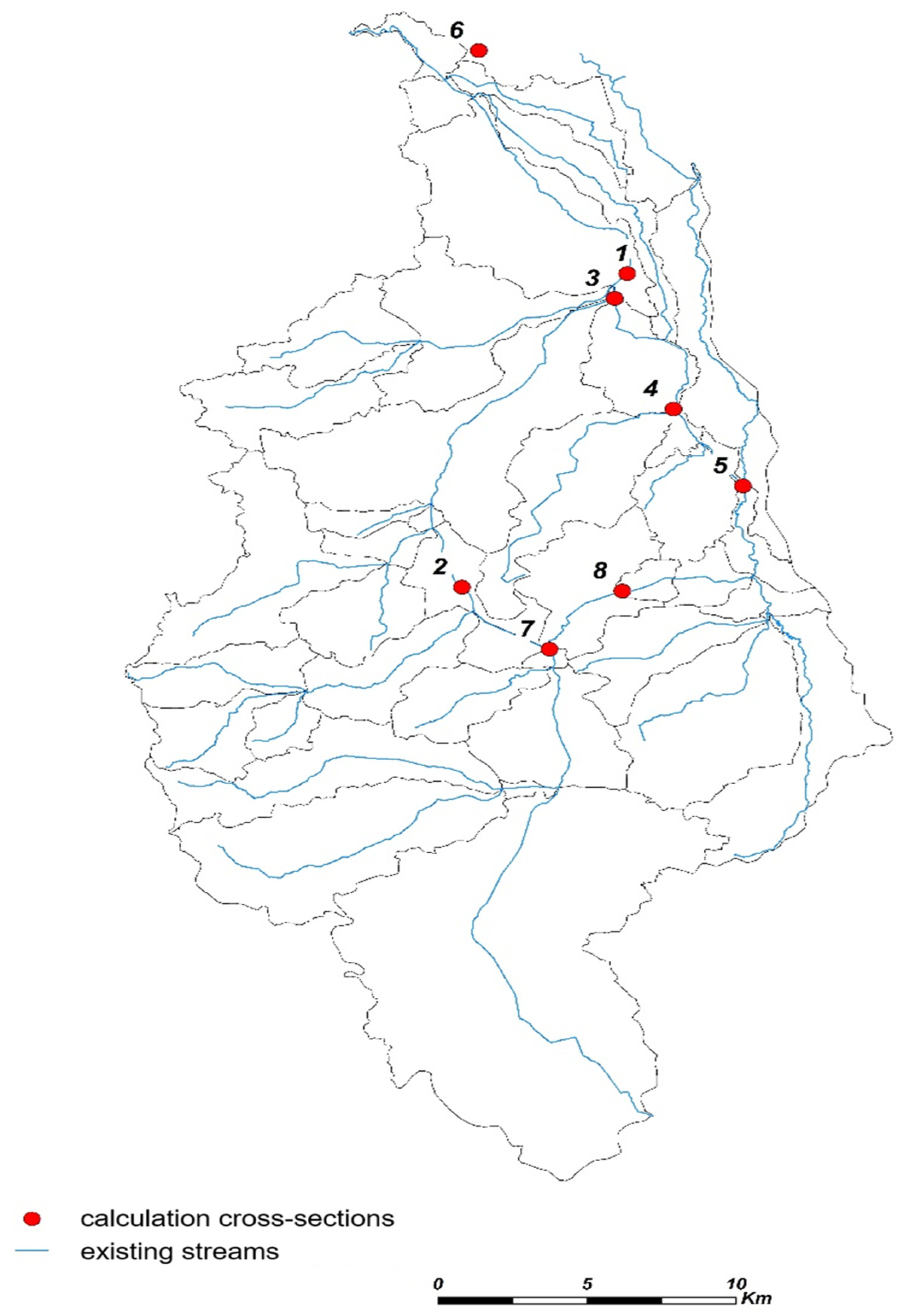

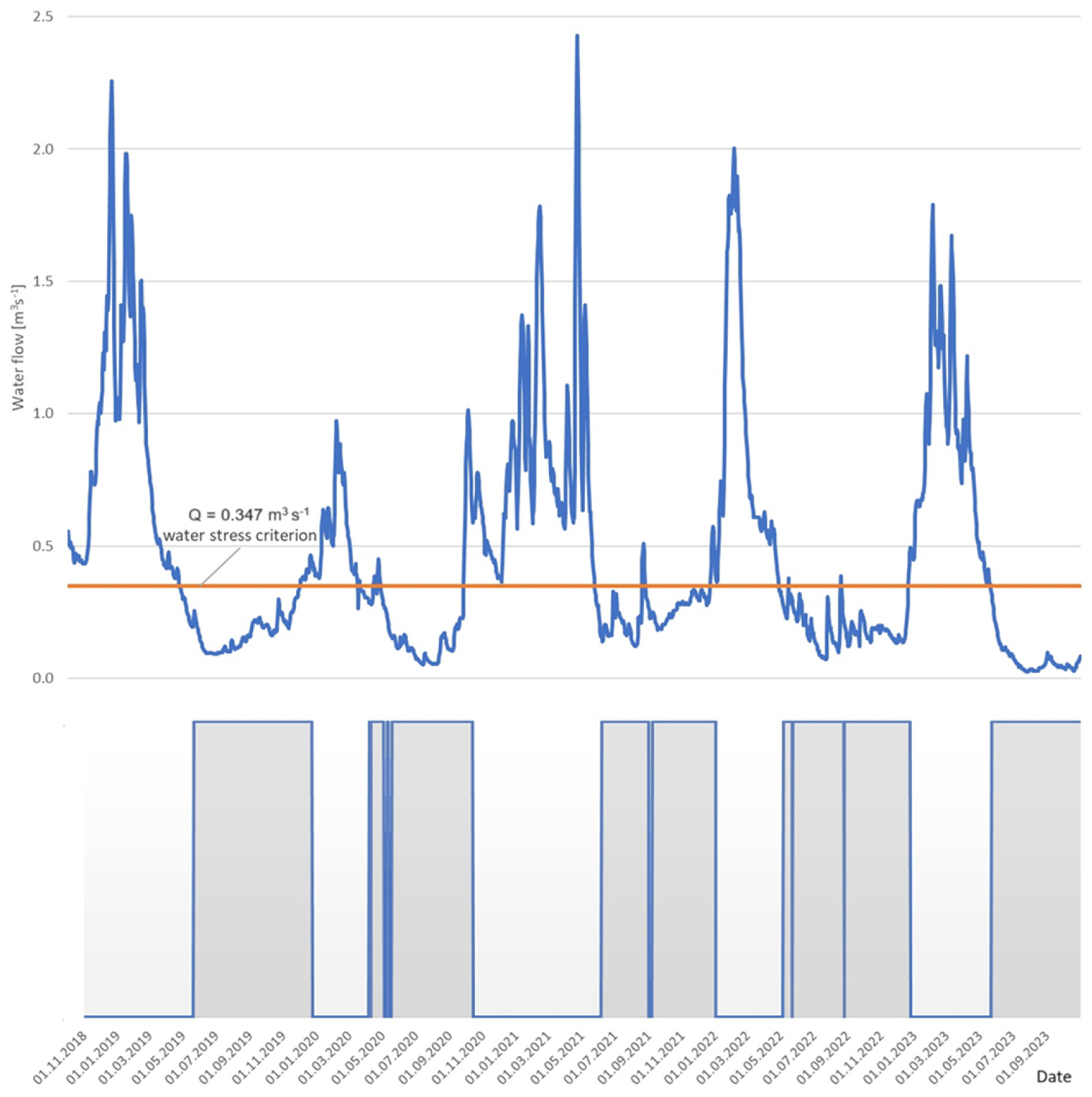
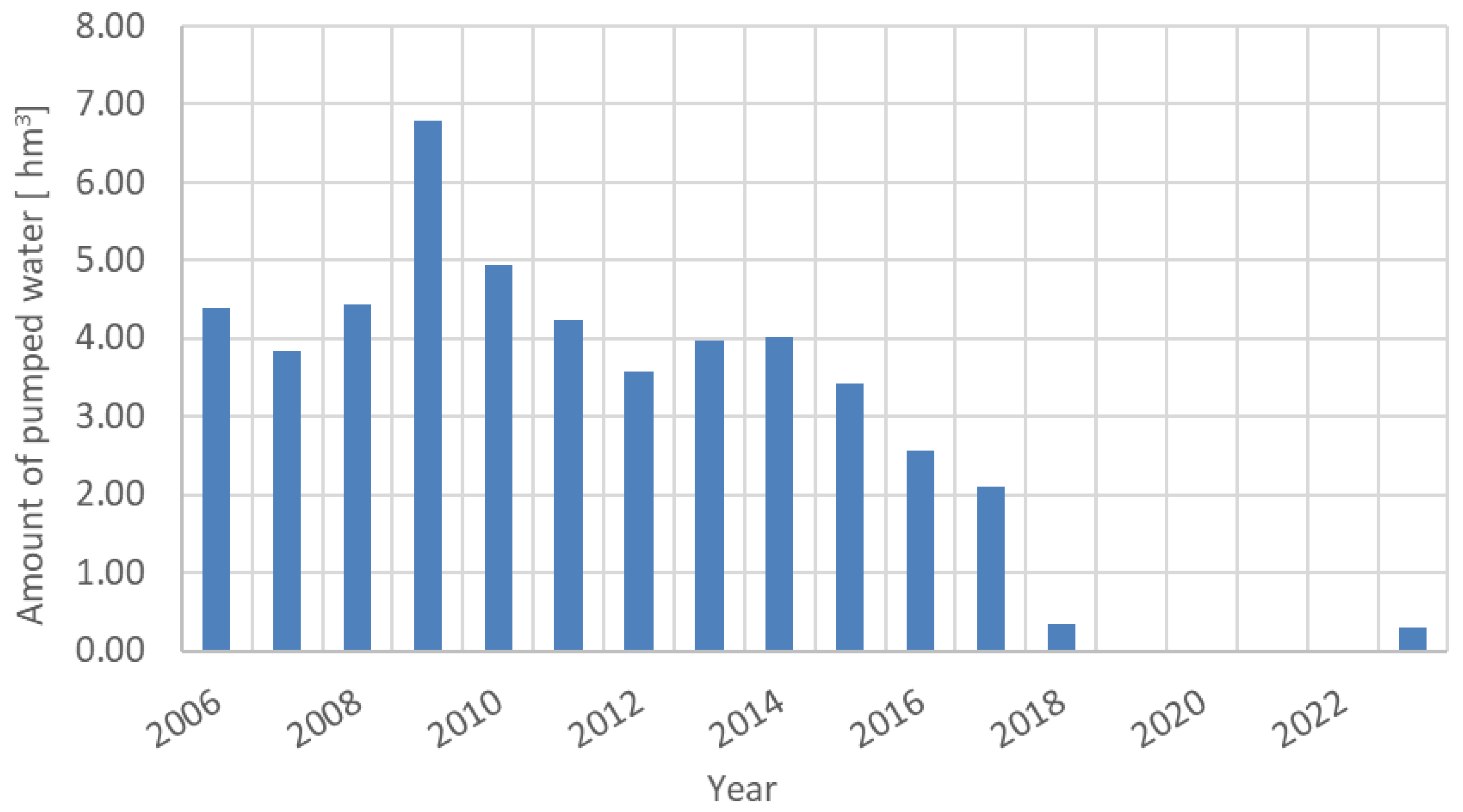
| Parameters | Coal-Fired Power Plant | Gas and Steam Block | |
|---|---|---|---|
| Investment costs [28] | larger | smaller | |
| Construction time [28] | longer | shorter | |
| Operating time [28] | longer | shorter | |
| Emissivity of substances g·kWh−1 [29] | SO2 | 3.2 | 0.08 |
| CO2 | 420 | 202 | |
| dust | 16.4 | - | |
| Calorific value [28] | MJ·kg−1 | 21–29 | 50 |
| GJ·m−3 | 24 | 35 | |
| Combustion process [28] | time | longer | shorter |
| Flame temp. °C | 2200 | 2100 | |
| Water consumption -median m3·MWh−1 [30] | Tower (cold storage) | 2.6 | 0.75 |
| Single-pass system | 0.95 | 0.38 | |
| Cooling lake | 2.06 | 0.91 | |
| Scenario | Flow | Time Period | Measurements | Model | Absolute Difference | Relative Difference |
|---|---|---|---|---|---|---|
| [m3 s−1] | [m3 s−1] | [m3 s−1] | [%] | |||
| Scenario 0 | AALF | 2019–2023 | 0.180 | 0.187 | 0.007 | 3.9 |
| AMAF | 0.980 | 0.970 | −0.010 | −1.1 |
| No Cross-Sections | Computational Profile Name | River | AALF [m3 s−1] | AMAF [m3 s−1] | ||||
|---|---|---|---|---|---|---|---|---|
| S0 | S1 | S2 | S0 | S1 | S2 | |||
| 1 | Kiełbaska—locality Cichów—road bridge | Kiełbaska Dolna | 0.180 | 0.164 | 0.185 | 0.934 | 0.898 | 1.307 |
| 2 | Kiełbaska weir power plant | Kiełbaska Środkowa | 0.086 | 0.375 | 0.374 | 0.395 | 0.542 | 0.542 |
| 3 | Estuary of Struga Janiszewska | Struga Janiszewska | 0.000 | 0.000 | 0.022 | 0.014 | 0.135 | 0.544 |
| 4 | Estuary of the Northeastern Ditch | North-Eastern Ditch | 0.000 | 0.000 | 0.000 | 0.001 | 0.001 | 0.001 |
| 5 | Teleszyna Sarbice weir | Teleszyna | 0.002 | 0.002 | 0.036 | 0.020 | 0.020 | 0.180 |
| 6 | Estuary of Teleszyna | Teleszyna | 0.198 | 0.198 | 0.052 | 0.287 | 0.287 | 0.267 |
| 7 | Teleszyna m. Przykona—DK 72 bridge | Teleszyna | 0.061 | 0.861 | 0.661 | 0.282 | 1.082 | 0.882 |
| 8 | Teleszyna tributary to reservoir Przykona | Teleszyna | 0.003 | 0.514 | – | 0.026 | 0.679 | – |
Disclaimer/Publisher’s Note: The statements, opinions and data contained in all publications are solely those of the individual author(s) and contributor(s) and not of MDPI and/or the editor(s). MDPI and/or the editor(s) disclaim responsibility for any injury to people or property resulting from any ideas, methods, instructions or products referred to in the content. |
© 2024 by the authors. Licensee MDPI, Basel, Switzerland. This article is an open access article distributed under the terms and conditions of the Creative Commons Attribution (CC BY) license (https://creativecommons.org/licenses/by/4.0/).
Share and Cite
Kałuża, T.; Kanclerz, J.; Hämmerling, M.; Janicka-Kubiak, E.; Zaborowski, S. Opportunities for the Transformation and Development of Power Plants Under Water Stress Conditions: Example of Adamów Power Plant. Energies 2024, 17, 6267. https://doi.org/10.3390/en17246267
Kałuża T, Kanclerz J, Hämmerling M, Janicka-Kubiak E, Zaborowski S. Opportunities for the Transformation and Development of Power Plants Under Water Stress Conditions: Example of Adamów Power Plant. Energies. 2024; 17(24):6267. https://doi.org/10.3390/en17246267
Chicago/Turabian StyleKałuża, Tomasz, Jolanta Kanclerz, Mateusz Hämmerling, Ewelina Janicka-Kubiak, and Stanisław Zaborowski. 2024. "Opportunities for the Transformation and Development of Power Plants Under Water Stress Conditions: Example of Adamów Power Plant" Energies 17, no. 24: 6267. https://doi.org/10.3390/en17246267
APA StyleKałuża, T., Kanclerz, J., Hämmerling, M., Janicka-Kubiak, E., & Zaborowski, S. (2024). Opportunities for the Transformation and Development of Power Plants Under Water Stress Conditions: Example of Adamów Power Plant. Energies, 17(24), 6267. https://doi.org/10.3390/en17246267






